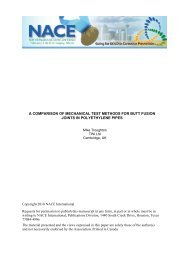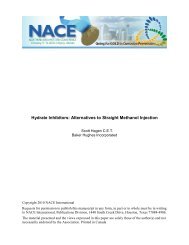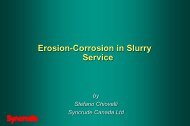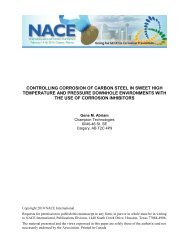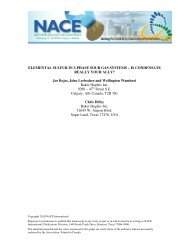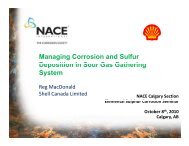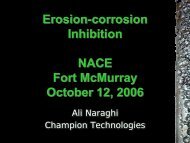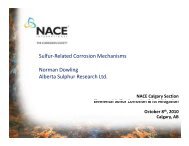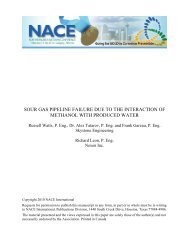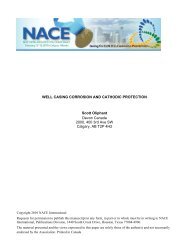Skystone FRP Water Tank Explosion - NACE Calgary
Skystone FRP Water Tank Explosion - NACE Calgary
Skystone FRP Water Tank Explosion - NACE Calgary
Create successful ePaper yourself
Turn your PDF publications into a flip-book with our unique Google optimized e-Paper software.
<strong>NACE</strong> International<br />
<strong>NACE</strong> <strong>Calgary</strong> International Section<br />
Non-Metallics Mini Symposium<br />
November 25, 2011
Examination of <strong>Explosion</strong> Failure of<br />
Aboveground <strong>FRP</strong> <strong>Water</strong> <strong>Tank</strong><br />
Alex Tatarov, Ph.D., P. Eng., Frank Gareau, P. Eng..
Failure Site
Operating Conditions<br />
• Pumpjack oil well.<br />
• Oil emulsion consisting of sweet natural gas, oil<br />
and water.<br />
• A treater separates the three phases.<br />
• The gas phase goes to a pipeline.<br />
• The oil and water phases are stored in<br />
atmospheric tanks and trucked away periodically.
<strong>Water</strong> And Oil Were Trucked Away<br />
• Treater (100<br />
bbl)<br />
• Three oil<br />
tanks (400 bbl<br />
each)<br />
• <strong>Water</strong> tank<br />
(400 bbl)
100 bbl Treater
Automatic Discharge Valves
Conditions Prior To Failure<br />
• Pumpjack was not operating.<br />
• Well valves were not closed, so the well was<br />
flowing.<br />
• Two oil tanks were empty. Third tank<br />
contained 6 feet of oil.<br />
• <strong>Water</strong> was trucked away two days prior to<br />
failure.<br />
• <strong>Water</strong> tank was almost empty. 1.5 feet of<br />
water from the bottom=30 bbl of water.
Conditions Prior To Failure<br />
• Good weather, no storms, no precipitation within last 24 hours.<br />
• Temperature from 9C to 19C (late April).<br />
• Nobody was on site at time of failure.
Damage At Top Of <strong>Water</strong> <strong>Tank</strong><br />
• Fire<br />
damage<br />
• Mechanical<br />
damage
Fire Damage At Top Of Failed <strong>Tank</strong>
Fire Triangle<br />
Confined space additionally required for explosion
Fuel Source 1: Gas From Oil <strong>Tank</strong>s<br />
• Upper parts of<br />
tanks are<br />
connected by 3<br />
inch overflow<br />
lines at the<br />
upper part of<br />
the shell, and<br />
by a 3 inch vent<br />
line at tank<br />
tops .
Fuel Source 2: Oil Film On <strong>Water</strong>
Fuel Source 3: Gas/Hydrocarbons<br />
Discharged From Treater With <strong>Water</strong><br />
• Pumping was shut down, but the well was still flowing.<br />
• Gas-to-Oil Ratio (GOR) changed.<br />
• More gas and light hydrocarbons came to a treater.<br />
• They came in more volatile manner.<br />
• <strong>Water</strong> discharge system could be activated to discharge liquid<br />
high in hydrocarbons.
Ignition Source<br />
1. Lightning Strike – Considered to be<br />
unlikely as good weather was reported.<br />
2. Heat – Discussed later; considered to be<br />
unlikely.<br />
3. Static electricity – Discussed later; most<br />
probable source.
Air Source: Thief Hatches<br />
• <strong>Water</strong> was<br />
trucked away<br />
prior to the<br />
failure<br />
• Thief-hatches<br />
(pressure 8 oz<br />
vacuum 4 oz)<br />
allowed air to<br />
get inside the<br />
tank
Two Possible Scenarios<br />
<strong>Water</strong> Dumping Scenario<br />
• Automatic discharge<br />
triggered water dumping.<br />
• <strong>Water</strong> dumping resulted in<br />
internal pressure increase.<br />
• High internal pressure blew<br />
the lid off.<br />
• Metal parts of the lid hit the<br />
railing, which resulted in<br />
sparking.<br />
• The gas-air mixture was<br />
ignited.<br />
Fire and <strong>Explosion</strong> Scenario<br />
• <strong>Water</strong> tank contained<br />
ignitable gas-air mixture<br />
• Ignition somehow occurred.<br />
• Gas burning resulted in<br />
increasing pressure and<br />
temperature.<br />
• High internal pressure blew<br />
the lid off.
<strong>Water</strong> Dumping Scenario:<br />
Possible Metal To Metal Spark
<strong>Water</strong> Dumping Scenario - Unlikely<br />
• The pressure increase due to water dump was calculated<br />
using the worst-case scenario:<br />
• All the thief-hatches are still closed (no gas escapes).<br />
• The flare line is completely plugged.<br />
• The entire volume of the treater filled with water.<br />
• All this water is dumped into the water tank.<br />
RESULTS:<br />
• ΔP = 1psi or 7.2% of 14 psi<br />
• <strong>Water</strong> flow 2 m 3 /min; 8 minutes to fill water tank<br />
• The maximum speed of water level rising is 19 cm/min.
External Fire And <strong>Explosion</strong> Scenario<br />
• Light hydrocarbons<br />
evaporated from the<br />
tanks during hot<br />
days and then<br />
condensed inside<br />
the valve at night.<br />
• Alternatively,<br />
measuring depth of<br />
oily water could<br />
contaminate the<br />
external surface.
Properties Of Common Hydrocarbons
Internal Spark and <strong>Explosion</strong> Scenario<br />
API Standard RP 2003 Protection Against Ignitions Arising Out of Static,<br />
Lightning, and Stray Currents in paragraph A.7 Ignition by Static<br />
Electricity states:<br />
• For an electrostatic charge to be a source of ignition, the following<br />
four conditions must be met:<br />
• a) a means of generating an electrostatic charge must be present;<br />
• b) a means of accumulating an electrostatic charge capable of<br />
producing an incendive spark;<br />
• c) a means of discharging the accumulated electrostatic charge in<br />
the form of an incendive spark (that is, a spark gap) must be<br />
present;<br />
• d) an ignitable vapor-air mixture must be present in the spark<br />
gap.
Internal Spark and <strong>Explosion</strong> Scenario<br />
• The electrostatic charge could be generated during flow of the<br />
water-oil mixture through pipes from the treater to the water<br />
tank.<br />
• The electrostatic charge could be accumulated on the oil<br />
surface, which is non-conductive.<br />
• All the pipes connected to the water tank were grounded.<br />
• The pipe openings to inside the tank contained plastic outlets.<br />
• The manway lid was non-metallic.<br />
• Bolts could not store energy necessary for ignition.<br />
• The length of the grounding cable was adequate, so it did not<br />
hang over the water surface.<br />
• No foreign conductive objects inside the tank.<br />
• There were no obvious spark gaps inside the water tank.
Static Electricity Spark Promoters<br />
• Non-conductive liquid<br />
• Metallic/conductive objects<br />
• Absence of grounding
Splash Filling<br />
NFPA 77 (Recommended Practice on Static Electricity)<br />
• Flow velocity of incoming liquid should be less than 1 m/sec until the outlet<br />
is submerged either two pipe diameters or 0.6 m, whichever is less.<br />
• For tank capacity of more than 50 m 3 , the inlet flow velocity could be<br />
increased to 7 m/sec after the fill pipe is submerged.
Fill Line Is Above Liquid Level<br />
• NFPA max. velocity for the non-submerged fill line V max = 1m/s<br />
• Inlet flow velocity V flow = 7.2 m/sec or ~ 7 times higher
Bottom Of Failed <strong>Tank</strong>
Failure Scenario<br />
• Flammable gas or gas-air mixture were present in water and oil tanks.<br />
• When the truck dumped the water, this mixture was sucked into the water<br />
tank through the overflow lines and through vent lines.<br />
• Air was sucked inside the water tank through thief hatches.<br />
• Thus the ignitable gas-air mixture was created inside the water tank.<br />
• A layer of oil was present on liquid surface in the water tank.<br />
• The well was still producing and the treater was in unusual and volatile<br />
conditions.<br />
• An automatic discharge releases hydrocarbons from the treater through<br />
water line.<br />
• Fluid containing hydrocarbons was splashed over the layer of oil in water<br />
tank with high velocity.<br />
• This resulted in a static electricity spark and gas ignition.<br />
• Ignition resulted in increase of gas pressure and temperature, and the lid<br />
blew off.
Proposed Modification
RECOMMENDATIONS<br />
• Minimize the chance of sparking due to static<br />
electricity. Install a non-conductive riser on the end<br />
of the drain outlet inside the water tank.<br />
• Eliminate or significantly reduce the oxygen level<br />
inside the tanks. Use fuel or sales gas to blanket the<br />
contents of both the water tank and the oil tanks.<br />
• Upgrade the automatic discharge system to a more<br />
reliable system.
QUESTIONS
CONTACT INFORMATION<br />
Alex Tatarov, Ph.D., P. Eng<br />
403-510-4394<br />
atatarov@skystone.ca<br />
Frank Gareau, P. Eng.<br />
403-516-4234<br />
fgareau@skystone.ca




